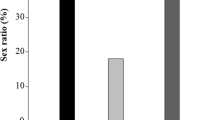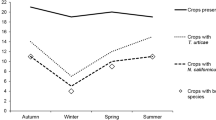Abstract
Bruchidius atrolineatus (Pic) is present in crops of Vigna unguiculata towards the end of the dry season at the beginning of September when pods start to form. Females lay many eggs on most available green pods. However, this oviposition behaviour results in an important egg mortality. During September, pods gradually reach maturity whilst new pods are formed. Females therefore have at their disposal a growing number of differently mature pods. Confronted with such a situation, B. atrolineatus females show an opportunist behaviour and lay most of their eggs on the most abundant stage, i.e. the most easily discovered stage (ripening green pods in mid-September or dry pods towards the end of September). However, they also lay eggs on other phenological stages no matter how abundant they are. B. atrolineatus females therefore show a certain behavioural plasticity enabling them to reproduce on all stages of pods whose maturity, chemistry and texture may differ. Larvae can develop either in maturing or dry seeds. The number of eggs laid from mid September is lower and lower whatever the phenological stage attacked. This decrease would be due to a reduction of the first generation adult bruchids and of the reproductive potential of females.
Callosobruchus maculatus appears in crops at the same time as B. atrolineatus, but oviposits preferentially on dry pods. Eggs are observed during the whole period of study, but the numbers laid are always low. With the increase in pod number, eggs are dispersed among the different substrates available. However, the average number of eggs laid on the pods remains constant. Despite the high mortality due to the oviposition behaviour of B. atrolineatus and to other factors (impact of hymenopterous parasitoids), these two bruchids cause important losses to seeds of V. unguiculata. Control methods against these pests should be envisaged.in the field before harvesting.
Résumé
Bruchidius atrolineatus (Pic) apparaît dans les cultures de Vigna unguiculata à la fin de la saison des pluies au début du mois de septembre lorsque les gousses commencent à se former. Les femelles déposent alors des pontes importantes sur la plupart des gousses vertes disponibles, mais un tel comportement entraîne une mortalité importante surtout au stade oeuf. Au cours du mois de septembre, ces gousses atteignent progressivement leur maturité et persistent dans les cultures mais en même temps, de nouvelles gousses se forment. Les femelles ont alors à leur disposition un nombre de gousses de plus en plus important et de plus en plus mûres. Face à une telle situation, les femelles de B. atrolineatus déposent la plupart de leurs oeufs sur le stade gousse le plus abondant et donc le plus facile à découvrir (gousses en cours de maturation à la mi-septembre, gousses sèches fin septembre). Mais elles émettent aussi un certain nombre d’oeufs sur les autres stades, quelle que soit leur importance numérique. Les femelles de B. atrolineatus présentent donc une certaine plasticité comportementale qui leur permet de se reproduire sur des gousses dont la texture et la composition chimique semblent très différentes. Les larves se développent également dans des graines en cours de maturation et dans des graines sèches. Les effectifs d’oeufs déposés à partir de la mi-septembre sont de plus en plus faibles, quel que soit le stade de maturation. Cette décroissance semble être due à une régression de la première génération de bruches dans la culture, parallèlement à une réduction des capacités reproductrices des femelles.
Callosobruchus maculatus (F.) apparaît dans les cultures à la même période que B. atrolineatus mais dépose ses oeufs de préférence sur les gousses sèches. Des pontes ont été observées durant toute la période de culture, mais elles sont toujours très faibles. Face à l’accroissement du nombre de gousses, il y a dispersion des pontes sur les différents substrats disponibles et le nombre moyen d’oeufs par gousse varie peu. Malgré la mortalité importante, surtout due au comportement de ponte des femelles de B. atrolineatus, mais aussi à d’autres facteurs (et notamment l’action des hyménoptères parasitoïdes), ces deux espèces de Bruchidae causent des pertes importantes aux graines de V. unguiculata. Les méthodes de contrôle contre ces ravageurs doivent être envisagées dès les cultures.
Similar content being viewed by others
References
Alzouma I. (1981) Observations on the ecology of Bruchidius atrolineatus and Callosobruchus maculatus (Coleoptera Bruchidae) in Niger. In The Ecology of Bruchids Attacking Legumes (Edited by Labeyrie V.), pp. 205–213. Junk, The Hague.
Alzouma I. and Huignard J. (1981) Données préliminaires sur la biologie et le comportement de ponte dans la nature de Bruchidius atrolineatus (Coléoptère Bruchidae) dans une zone sud sahélienne au Niger. Acta oecol. 2, 391–100.
Alzouma I., Huignard J. and Leroi B. (1985) Etude du comportement de ponte de Bruchidius atrolineatus au cours de la maturation des gousses de sa plante-hôte (Vigna unguiculata) et de ses conséquences sur le dével-oppement des oeufs. Ann. Soc. ent. Fr. 21, 207–217.
Bach C. E. (1980) Effects of plant density and diversity on the population dynamics of a specialist herbivore the striped cucumber beetle Acalvmma vittata. Ecology 61, 1515–1530.
Balachowsky A. S. (1962) Entomologie Appliquée à l’Agriculture. Masson, Paris.
Baranyouits (1944) Der Erbsenkäfer (Bruchus pisorum). Novenyegeszeg. Eukön. 2, 208–276.
Booker R. H. (1967) The infestation of cowpeas in northern Nigeria. J. stored Prod. Res. 3, 1–15.
Caswell G. H. (1961) The infestation of cowpeas in the western region of Nigeria. Trop. Sei. 3, 154–158.
Decelle J. (1981) Bruchidae related to grain Legumes in the Afro tropical area. In The Ecology of Bruchids Attacking Legumes (Edited by Labeyrie V.), pp. 193–197. W. Junk, The Hague.
Derr J. A. (1980) The nature of variation in life history characters of Dysdercus bimaculatus a colonizing species. Evolution 34, 548–557.
Dingle H. (1982) Function of migration in the seasonal synchronization of insects. Entomologia exp. appl. 31, 36–48.
Dingle H. and Arora G. (1973) Experimental studies of migration in bugs of the genus Dysdercus. Oecologia 12, 119–140.
Emden H. F. van and Williams G. F. (1974) Insect stability and diversity in agroecosystems. Ann. Rev. Ent. 19, 445–475.
Francq W. (1981) Etude de l’activité reproductrice femelle du comportement de ponte et de l’influence de la densité larvaire sur le développement post embryonnaire chez Callosobruchus maculatus sur les gousses et graines de Vigna radiata (L.) D.E.A. Université de Tours.
Fuseini B. A. and Kumar R. (1975) Ecology of cotton stainers (Heteroptera, Pyrrhocoridae) in Southern Ghana. Biol. J. Linn. Soc. 7, 113–146.
Germain J. F. (1981) Contribution à l’étude de Bruchidius atrolineatus au laboratoire. Quelques aspects descriptifs. Influence de la plante-hôte et de l’accouplement sur l’activité reproductrice des femelles. D.E.A. Université de Tours.
Germain J. F., Huignard J. and Monge J. P. (1985) Influence des inflorescences de la plante-hôte Vigna unguiculata sur la levée de la diapause de Bruchidius atrolineatus Pic. Entomologia exp. appl. In press.
Huignard J., Rojas-Rousse D. and Alzouma I. (1984) L’activité reproductrice de Bruchidius atrolineatus en zone sahélienne. Mise en évidence d’une diapause imaginale. Insect Sei. Applic. 5, 41–63.
Johnson C. D. and Slobodchikoff C. N. (1979) Coevolution of Cassia (Leguminosae) and its seed beetle predators (Bruchidae). Environ. Ent. 8, 1059–1064.
Leroi B. (1976) Importance des relations biocénotiques dans la dynamique des populations de la mouche du céleri Philophylla heraclei (Diptère, Tephritidae), en Touraine. Thèse Doctorat d’Etat, Université de Tours.
Nuto Y. (1984) Analyse de la reproduction et du développement de deux espèces de Bruchidae Bruchidius atrolineatus et Callosobruchus maculatus dans les cultures de Vigna unguiculata en zone sahélienne. Thèse 3è Cycle, Université de Tours.
Pajni H. R. and Sood S. (1975) Effect of pea pollen feeding on maturation and copulation in the beetle Bruchus pisorum. Ind. J. exp. Biol. 13, 202–203.
Parnell J. R. (1966) Observations on the population fluctuations and life histories of the beetle Bruchidius ater and Apion fuscivostre on broom Sarothamnius scoparius. J. Anim. Ecol. 35, 157–188.
Pescho G. R. and Houten R. J. van (1982) Pollen and sexual maturation of the pea weevil. Ann. ent. Soc. Am. 75, 439–443.
Pimentel D. (1961) The influence of plant spatial patterns on insect populations. Ann. ent. Soc. Am. 54, 61–69.
Prevett F. P. (1961) Field infestation of cowpea (Vigna unguiculata) pods by beetles of the family of Bruchids and Curculionids in northern Nigeria. Bull. ent. Res. 52, 535–545.
Rauscher M. D. (1983) Alteration of oviposition behavior by Battus philenor butterflies in response to variation in host plant density. Ecology 64, 1028–1034.
Southgate (1978) The importance of the Bruchidae as pest grain legumes, their distribution and control. In Pest Grain Legumes (Edited by Singh S. R., Emden H. van and Taylor T. A.), pp. 219–229. Academic Press, London.
Southwood T. R. E. and Way M. J. (1970) Ecological background to pest management In Concepts of Pest Management (Edited by Rabb R. L. and Guthrie F. F.), pp. 6–29. North Carolina State University Press, Raleigh, N.C.
Tahvanainen J. O. and Root R. B. (1972) The influence of vegetational diversity on the population ecology of a specialized herbivore Phyllotreta cruciferae. Oecologia 10, 321–346.
Umeya K. (1966) Studies on the comparative ecology of bean weevils—I. On the egg distribution and the oviposition behaviours of three species of bean weevils infesting azuki beans. Res. Bull. PL Prot. Japan 3, 1–11.
Author information
Authors and Affiliations
Rights and permissions
About this article
Cite this article
Huignard, J., Leroi, B., Alzouma, I. et al. Oviposition and Development of Bruchidius atrolineatus (Pic) and Callosobruchus maculatus (F.) (Coleopterae: Bruchidae) in Vigna unguiculata (Walp) Cultures in Niger. Int J Trop Insect Sci 6, 691–699 (1985). https://doi.org/10.1017/S1742758400002927
Received:
Revised:
Published:
Issue Date:
DOI: https://doi.org/10.1017/S1742758400002927




